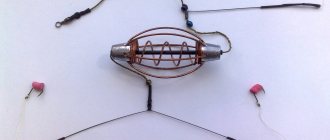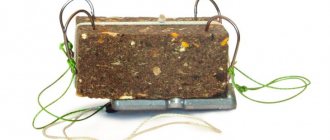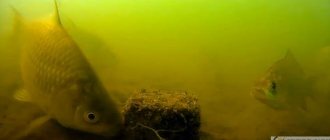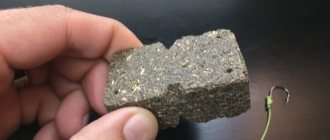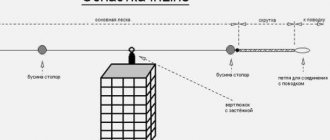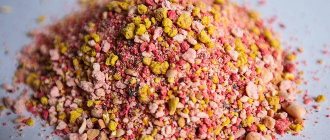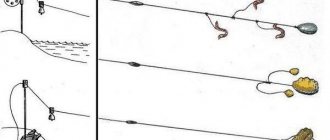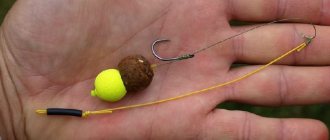Fishing for carp on top rightfully refers to a non-standard fishing method that differs significantly in the principle of supplying bait to the fish. The sports fishing community does not consider this method to be a legitimate method of hunting and this trend has become widespread purely in amateur fishing. Sports fishermen consider it inhumane to catch carp on top, since the numerous hooks sucked in by the fish can cause serious damage to the gills, or even lead to the death of the caught fish.
Among amateur fishermen there are a lot of avid carp fishermen who, having honed the skill of catching a trophy, successfully cultivate the method without particularly injuring the fish. In addition, there is no official ban on fishing with this method, and bait can be purchased without any problems in many fishing stores in certain manufacturing parameters, and if desired, you can make a makushatnik for catching carp with your own hands. The equipment itself and the rods are assembled from standard carp fishing elements. To prepare for a fishing session using this method, the angler will not need to spend a lot of money; he just needs to familiarize himself with the essence of the process, modify the equipment and enjoy the anticipation of the bites of a catch that is significant in size.
Operating principle
- The tackle with the cube is thrown into the water.
- After 30 minutes, the makha begins to spread its very attractive smell throughout the pond.
- The carp approaches the cube and begins to suck on it, sucking in the hooks along with the top.
The carp, having swallowed the hook, tries to hide. It is at this moment that you should hook and start fishing for carp.
Makukha can be purchased at the market. There they sell it in large circles, up to 40cm in diameter. Before buying it, you should make sure that it is fresh and does not emit aromas of spoilage.
- Makukha has the smell of halva and no others.
- It should crumble a little.
- Have no external signs of depravity.
The consistency of the top, or rather, its density can be different. A harder top is more suitable for fishing in currents, while a less hard top can be used for fishing in still water. The cubes should be stored in a glass jar with a screw top. The cubes are sprinkled with crumbs formed after slicing.
Preparing gear for makushatnik
It is unlikely that you will be able to buy ready-made tackle in a store, but assembling it yourself, from separately purchased elements, will not be difficult. You can find several design solutions for the makushatka, which belong to individual fishermen. They all have structural differences, but the principle of application is the same. In this case, there is a huge field for experimentation. By choosing this path you can get gear that has unique capabilities.
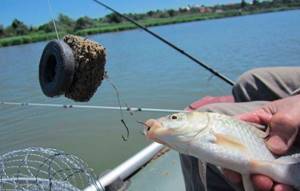
- A rod for a spinner must be able to withstand the weight of the spinner and the weight of the carp, which can be quite significant. Therefore, the rod must be stiff. The length of the rod is selected within 4 meters or more.
- The reel is also chosen to be powerful, always inertia-free, size 3000-4000, in order to accommodate a sufficient amount of fishing line.
- The thickness of the fishing line is selected depending on the size of the carp in the pond. The diameter can be in the range of 0.25-0.45mm, and the length of the fishing line can be at least 150m.
- Carp hooks are used, with a long shank, sizes No. 6-No. 8.
- The choice of sinker plays a huge role, since you have to fish in currents or in still water. In currents, dovetail or horseshoe type sinkers are mainly used. When fishing in still water, it is possible to use sinkers of any shape.
If you plan to catch small carp, weighing no more than 2 kg, then ordinary, not so powerful fishing rods will do. At the same time, you should seriously approach the issue of choosing fishing line. As a rule, monofilament is used to catch carp, as it tends to stretch and dampen the jerks of the fish. This can be an ordinary fly fishing rod, 4-6 meters long, equipped with a spinning reel.
Encyclopedia of Fisherman and Hunter
Most fishermen prefer boilie tackle, but despite its popularity, carp fishing is
still takes pride of place among this type of fishing.
Sports fishing professionals use the method of fishing with fishing gear, without exception. And ordinary amateurs do not stop using the top for catching carp, and at the same time have a good catch.
The basis of using such gear is to attract fish without making much effort.
Tackle for catching carp on top
The equipment of such tackle is not complicated; it includes a fishing line that serves as a leash, several hooks and a weight.
As for the cargo. The important point is its weight and shape. If you fish in a strong current, the load must ensure its immobility. If you do not correctly calculate the weight of the load, it will be carried away by the current along with the hooks, and the top itself will remain in place.
Fishing in this case will not bring the desired result, it will be in vain. As for the shape of the load, it greatly influences if carp is caught on the top
. This usually occurs in bodies of water with silt at the bottom. Statistics show that flat-shaped loads do not sink into silt. The hooks must be of excellent quality.
Disagreements exist precisely in such a situation, starting with the number of hooks and stopping at the placement of the hooks in the crown when casting. Let's try to analyze these controversial issues.
As for the number of hooks, I think there should be four (2 on both sides). Fishermen claim that two fish are enough to hook a carp. Could there really be 2 extra? It would probably be better this way to increase the chances.
The question of whether it is worth placing hooks in the top of the hook when casting is also considered differently. Some people think that this should not be done, but on the other hand, it is worth noting that the hooks do not get tangled.
If they do not release when casting the tackle, they will still fall out when the top begins to swell.
As for the fishing line, for this type of gear it will play the role of a leash, and in some cases, a component of the structure of securing the top.
Fishing for carp on the top
may have several problematic moments, namely when small fish bite repeatedly. Small crucian carp will be able to accept large hooks. To prevent this situation, put corn or peas on the hooks.
If you wear peas, then use peas with the appropriate smell. This will be a good combination when fishing, the size of the top will prevent small fish from swallowing the hook, while at the same time attracting carp. The same system can be used when catching carp on top
.
I advise you to feed the place where you are fishing with a small amount of bait.
Using makukh for makushatnik, cut it at the place where you are going to fish. If you want to give it a better smell, place it in vegetable oil.
Video “Carp fishing on top” . Small but nice carp)
VN:F [1.9.22_1171]
Source: https://fishinggold.ru/ribi/karp-sazan/lovlya-karpa-na-makuhu.html
Installation of the top cover
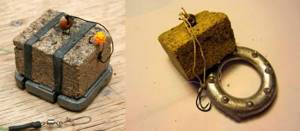
To assemble a makushatnik, you must have the following components:
- Lead sinker of the appropriate shape.
- Wire.
- Elastic bands – 2 pcs.
- Monoline, diameter 0.25-0.4mm.
- Hooks – 2 or 4 pcs.
- Pressed bars of sunflower cake.
Assembling the tackle on your own is not very difficult and quite accessible, you just need to show a little effort.
- A thin lead plate is wound across the wire. In this case, small rings are formed at both ends.
- The square of topcoat is held in place with rubber bands. The elastic bands should be black to blend in with the crown.
- A block of makukha is placed on a metal plate and secured with rubber bands. The size of the block must correspond to the size of the metal base.
- A swivel is attached to one of the wire rings.
- Leashes with hooks, the tips of which are directed downwards, are attached to the other ring. When the top of the head is assembled, the hooks are hidden in the top of the head so that the carp does not notice them prematurely.
We can say that the tackle is ready for use and all that remains is to attach it to the main fishing line. To become more familiar with such equipment as a makushatnik, you can watch the corresponding video.
Makushatnik for carp - Lifehack!
What is carp top?
Makukha is a tightly compressed cake in the form of a bar or cube, left over after the production of sunflower oil. It is based on ground husks and kernels of sunflower seeds.
Makukha is a bait and groundbait at the same time. Once in the water, the block of cake gradually soaks, emitting an attractive halva aroma around which no carp, even a well-fed one, is indifferent. The fish goes to the source of the smell and grabs the bait.
In fishing stores, makukha is sold in different types of packaging. The most common is in round or rectangular sheets of different thicknesses. Sold, as a rule, by weight, less often by piece. At the reservoir, the fisherman independently cuts it into pieces of the required size.
Tip: You can successfully catch carp only using fresh, not dried out product.
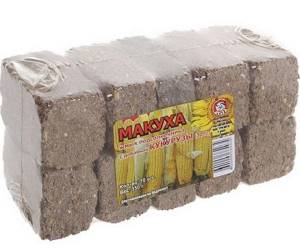
A good poppy seed has a yellowish-black color and a pleasant smell of sunflower oil. There cannot be any mold stains or visible delaminations on it. When pressing on the block, the finger should spring slightly; overdrying or waterlogging is unacceptable.
How to prepare super-catchy carp cake yourself
Every fisherman can make a carp hook with his own hands at home. To do this, you need to purchase sunflower seeds. It is advisable to take raw, slightly dried material rather than fried. The manufacturing process for this nozzle is as follows:
- Grind the seeds in a mixer or crusher. The product should have a moist, loose consistency, from which a pleasant smell of sunflower oil emanates.
- Wrap the resulting mass in gauze and leave to dry at room temperature.
- To form cubes you will need a press, which can be easily made from two metal plates curved to the desired shape. They are bolted together at 2–4 points.
- All that remains is to place the dried workpiece in the press, tighten the bolts and leave for several hours.
Recommended reading: Catching perch in winter with a baitfish
As a result, we get homemade flour that is in no way inferior to the store-bought product. Moreover, fishermen can independently regulate its density, taking into account the upcoming fishing conditions.
Cool video about making catchy makukha yourself:
On a note! It is better to place the finished briquettes in zip lock bags and store them in the lower compartments of the refrigerator. This way the bait will retain its original density for a long time, will not dry out, and will not lose its taste characteristics or attractive smell.
Makushatnik with sliding weight
You can consider another version of the makushatnik, which uses a sliding weight.
- A stopper is installed on the main line, usually monofilament, a sinker is put on, and then another stopper is placed.
- A hole should be drilled in the cube of sunflower cake through which a loop with a fishing line on which the clip is attached is pulled.
- Leashes with hooks are attached to the loop of the main line.
- Slots are made in the corners of the pressed cube, in which hooks are hidden, the stings of which are directed outward.
It should be noted that there should be no foreign odors coming from the pressed macadamia, especially the odors of diaper rash. The tackle should be collected directly near the reservoir so that the pressed cubes cannot lose their aromatic properties.
Choosing a fishing spot
Carp constantly migrate across the pond in search of food. At the same time, he will never be in a place where there is no food. Its favorite places are holes, drops and edges, as well as thickets of reeds and other vegetation. It may be in an area with a clean bottom, where you can always dig something and profit. As a rule, it prefers to be at depths of 2 meters or more. It is advisable to choose clean places, without the presence of obstructed trees and snags. The carp, having grabbed the bait, will try to go with it into the depths, or even better into a snag. Therefore, there is no point in delaying hooking and fishing.

You should also not choose areas with silt, as the bait can get into the silt and the carp will not notice it.
- It is better to catch carp on the top of the fish after lunch, in the late afternoon.
- It is more convenient to catch carp and other fish during the day, since all the gear is in sight and there are no problems with fishing.
- At night, carp can be caught more readily, and serious specimens may be caught.
- For night fishing, you should prepare in advance and remove all unnecessary items from the fishing spot. These can be stones, logs, sticks, etc.
Methods for installing rigs with bait from makukha
The first method of equipment is done according to this principle:
- Place the stopper on the fishing line.
- Put on the flat weight and put on the second stopper again.
- Secure with a fishing loop to the fishing thread.
Second installation method:
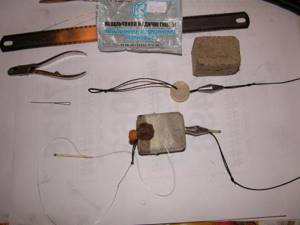
- Drill a small hole in the top and carry out installation.
- Attach hooks and leashes to the clip and loop.
Third installation method:
- Secure a loop or swivel at the end of the fishing line.
- Attach hooks and leashes to them.
- Using a nylon cord, attach the bait to the weight by drilling a small hole in the center.
- Insert the hooks directly into the bait form.
It is best to fish with bait such as makukha in late spring and early summer. It is at this time that the fish begins to actively feed on plant foods and will willingly peck at the top of the head.
It is advisable to fish with this bait in small bodies of water where there is no strong current. Particular attention should be paid to the time of fishing on the top.
The most suitable time of day is:
- lunchtime on hot days, when the fish go to the bottom, where this bait is placed.
At dawn and in the evening, the fish rises to the upper layers of the water, and therefore may simply not notice the bait, which is located at the very bottom.
Catching fish during the day using bait from makukha is not particularly difficult, but night fishing has its own characteristics:
- at night, the makuha has more opportunities to spread over long distances;
- At night, carp come very close to the shore to feed well , which increases the chance of catching it.
Technique for catching carp with a fishing rod
Carp picks up odors from a great distance, so they will certainly respond to the aroma of sunflower cake. For greater efficiency, it is better to feed the fishing spot in advance. For this purpose, bait is prepared, which should contain whole grains of corn, wheat or peas. Such large fractions can keep the carp at the biting point.

After the tackle has been fully prepared and the cube made from macaque has been strengthened, it is thrown into the water. After about 2-3 hours, the cube dissolves under the influence of water. This means that after this time the makukha cube should be replaced with a new one. As soon as the carp smells the smell of corn, it will immediately swim up to the cube and begin to taste it. Carp works like a vacuum cleaner: it sucks in food along with foreign objects and then separates them into edible and non-edible components. Thus, he will be able to suck in the hook along with the crown. When you try to swallow it, the hook will certainly get caught on the lip.
The fisherman's task is to carefully land the fish. Carp can be killed by releasing the line tension from time to time. It is much easier to catch a tired carp. A fisherman must have a landing net in his arsenal, otherwise it is unlikely that he will be able to catch a large specimen of carp.
